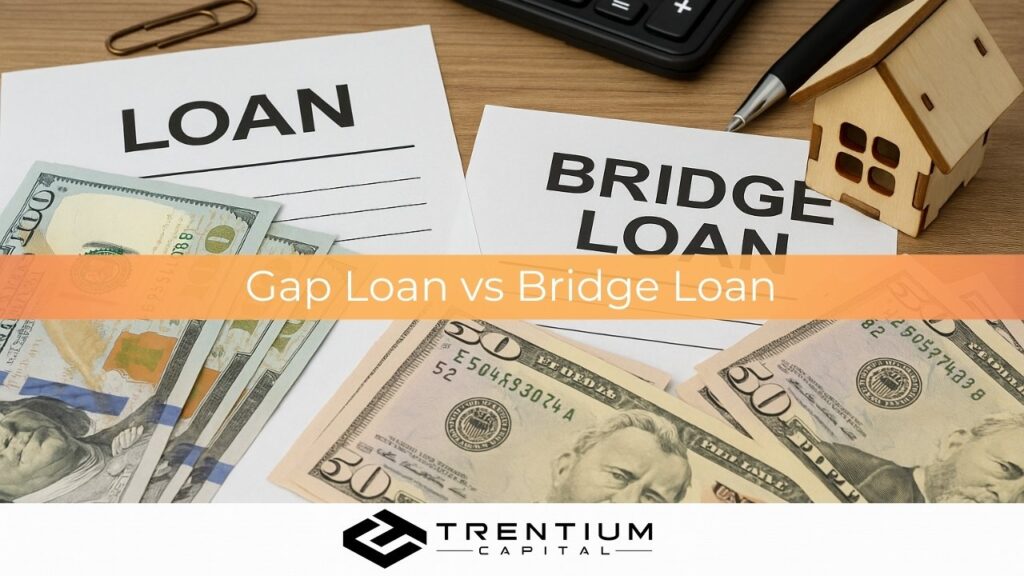Confused about gap loans and bridge loans? Are gap and bridge loans the same thing, or is there a crucial difference you should know before choosing one for your real estate or business financing needs?
Understanding the subtle distinctions between gap and bridge loans could save money, time, and stress if you navigate a temporary financial shortfall during a property transaction or business transition. In today’s fast-paced real estate and investment climate, making the right funding choice at the right time is everything.
Let’s break down the core differences between a gap loan and a bridge loan so you can choose the financing tool that best aligns with your goals.
What Is a Gap Loan?
A gap loan is a short-term financing solution used to “fill the gap” between the need for immediate funding and long-term financing or permanent capital availability. It is often used in commercial real estate or development scenarios where construction is complete, but permanent funding is not yet available.
Gap loans are commonly used to:
- Cover the final stages of construction or development
- Fund operations during a temporary shortfall
- Serve as a placeholder while waiting on a larger, future loan
Key Features of a Gap Loan
- Short-term duration (typically 3–12 months)
- Interest-only or balloon payment structure
- Often subordinate to the primary loan
- Used in commercial and development finance
What Is a Bridge Loan?
A bridge loan is a short-term loan that helps borrowers “bridge the gap” between selling one asset and buying another. These loans are most common in residential and investment real estate, assisting buyers to fund the purchase of a new property before selling their current one.
Bridge loans are popular among:
- Homebuyers need to secure a new home before selling their old one
- Real estate investors acquiring new properties
- Companies are buying new equipment or real estate while awaiting asset sales
Key Features of a Bridge Loan
- Short-term financing (6–12 months on average)
- Backed by existing collateral (such as home equity)
- Fast approval and funding times
- Typically repaid upon sale of the existing asset
Terms & Structure
- Gap Loans often come with balloon payments and are secondary to existing financing.
- Bridge Loans typically rely on property equity and are often the primary funding source.
Borrower Profile
- Gap Loans are more common among developers, businesses, or commercial investors.
- Bridge Loans cater to homeowners, investors, or buyers needing fast liquidity.
Pros and Cons of Each Loan Type
Gap Loan
Pros:
- Flexible for ongoing projects
- It can be layered with other financing
- Helps complete deals under time constraints
Cons:
- It may come with higher interest rates
- Not always suitable for individual borrowers
Bridge Loan
Pros:
- Quick access to cash
- Ideal for real estate transitions
- Based on current home equity
Cons:
- Short repayment window
- Requires strong credit and collateral
FAQs About Gap Loans and Bridge Loans
1. Are gap loans and bridge loans the same?
No. While both provide temporary funding, gap loans are standard in commercial finance and fill gaps between project stages or funding rounds. In contrast, bridges are used to purchase a new property before selling an existing one.
2. Can I use a bridge loan for business purposes?
Yes, but bridge loans are primarily structured for real estate transactions. A loan or working capital loan might be more appropriate.
3 Which loan is faster to fund, a gap loan or a bridge loan?
Bridge loans are typically faster, especially when backed by equity. Gap loans, on the other hand, may involve more underwriting, depending on the project and lender.
4. Do both loan types require collateral?
Yes. Both gap and bridge loans usually require collateral, such as property or project equity.
5. Who offers bridge loans for real estate investors and homeowners?
Trentium Capital is a trusted provider of flexible bridge loan solutions tailored to real estate professionals and individual borrowers alike.
Conclusion
Regarding loan vs bridge loan, the right option depends on your specific scenario. If you’re navigating construction timelines, commercial development, or refinancing delays, a gap loan can be the flexible financing solution you need. On the other hand, if you’re buying a new home before selling your current one or an investor making a time-sensitive purchase, a bridge loan is your best bet.
Regardless of your situation, short-term financing doesn’t have to be confusing, especially when you have the right lender.
Ready to Move Fast?
At Trentium Capital, we specialize in fast, flexible bridge loan solutions tailored to real estate buyers, investors, and businesses who need capital without the wait. Our streamlined process, personalized terms, and expert team help you close deals quickly and confidently.
👉 Contact Trentium Capital today to get pre-approved and discover how a bridge loan can help you seize your next opportunity before it’s gone.



